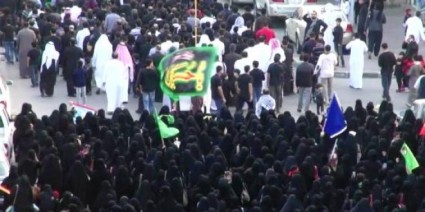Saudi King Abdullah tries to buy-off the Revolution
House of Saud’s doomed bid for survival
6 January, 2013 – By Finian Cunningham – PressTV
The largesse of the Saudi rulers is only viable if it can sell oil at a price. The trouble is that the world economy is flat on its back. The kingdom’s top five customers are the US, Japan, China, South Korea and India. But Asian demand for Saudi oil is dependent on their export-led economies finding customers in the US. The slowing Asian economies, China in particular, is evidence of the structural problems of American and European societies, where poverty and unemployment have become endemic under relentless austerity measures. ”
Saudi Arabia’s latest budget announcement – the biggest in the kingdom’s 80-year history – had the world’s financial press swooning last week. It came as an almost delirious distraction from the relentless austerity news coming out of the United States and Europe.
USD219 billion is to be pumped into the Saudi economy by the government in Riyadh. In an age of capitalist austerity, the Saudi spending plan may seem like socialism on steroids.
By contrast, as part of its so-called fiscal cliff deal, Washington is planning to execute USD110 billion in cuts to government spending later this year. Bear in mind that the Saudi population is only six percent of the United States, the House of Saud’s largesse is, to put it mildly, wildly lavish. Such spending plans are in stark contradistinction from the rest of the world, beleaguered as it is with recession and fiscal bankruptcy.
The world’s other exceptional big government spender, China, announced late last year that it was allocating some USD150 billion on new infrastructure projects – a relatively modest fraction of the Saudi spend.
A Saudi finance ministry was quoted by the Financial Times as saying that the new budget would focus on “investment programs that enhance strong long-term sustainable economic growth and employment opportunities for citizens”.
While US President Obama is targeting health and education for draconian cuts, the biggest part of the Saudi spend is conversely on these same public goods – some 37 percent – or USD80 billion.
But this largesse from the House of Saud towards its 20 million subjects is less to do with generosity and well-being of the nation and more to do with trying to buy political survival. The bigger the largesse, the greater the sign of desperation among the Saudi rulers.
Since the eruption of political protests across the Arab region against Western-backed autocratic rulers in early 2011, the government in Riyadh has increased its year-on-year public spending by nearly 60 percent compared with 2009 and 2010. Notably, in March 2011, shortly after the Arab uprising deposed Tunisia’s Ben Ali and Egypt’s Mubarak and was knocking on Saudi Arabia’s backdoor in Bahrain, the House of Saud made an exceptional budget announcement then of USD130 billion – to fund new housing, wage increases and unemployment welfare.
Given these recent public expenditures by the House of Saud, one would expect the kingdom to be a veritable land of plenty and contentedness. This is far from the social reality. Saudi Arabia continues to reel from weekly protests against its rulers. Indeed, the protests have become increasingly vociferous in calling for the downfall of the Saudi regime – despite the inordinate wads of money that the regime is throwing at the public.
The apparent robust fiscal position of the Saudi rulers actually points up deep structural weaknesses and conflicts within the kingdom. It is a symptom of the many contradictions in Saudi society that are driving discontent against the ruling order.
Some 70 percent of the Saudi population is under the age of 30. This demographic is in contrast to the decrepit House of Saud led by the aging and ailing King Abdullah. The House of Saud is reckoned to comprise an inner circle of about 2,000 family members – some 0.1 of the country’s total population – most of them the progeny of the founder of the state, King Abdulaziz Ibn Saud. The latter is reputed to have had as many as 22 wives and sired more than 40 sons, of whom 20 are still alive.
Following the death of Ibn Saud in 1953, the throne passed on to his sons. Subsequently, Saudi Arabia’s tightly controlled hereditary system mandated that rule would from then on pass from brother to brother, rather than father to son. King Abdullah (89), who reportedly went into a coma last month following a 14-hour surgical operation, is the fifth son of Ibn Saud to take the throne since 1953. …more































Add facebook comments
Kick things off by filling out the form below.
Leave a Comment